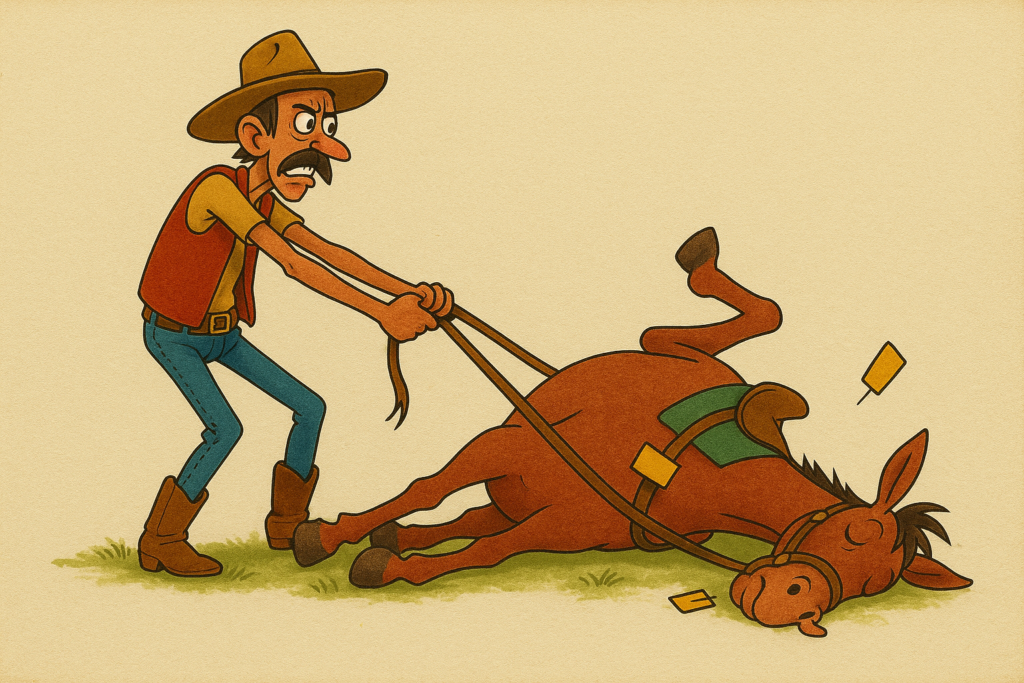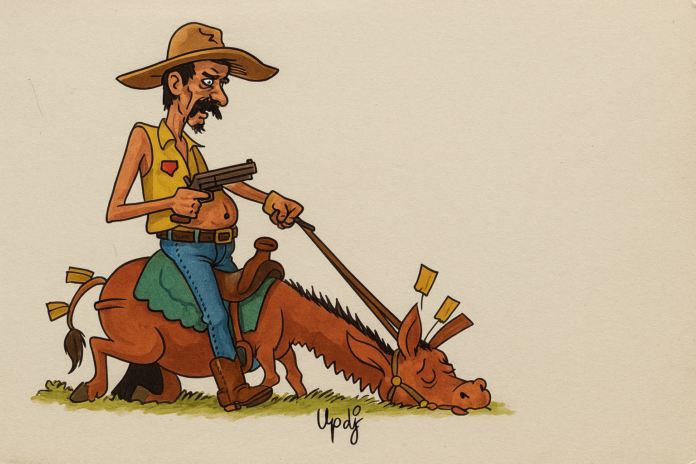[Reading level: C1 – Advanced]
Imagine yourself riding a horse on a long journey, and the horse gradually slows down, stumbles, and eventually collapses. You pause. Maybe it just needs rest, so you wait. When that doesn’t help, you try feeding it, coaxing it with kind words, then harder measures—a tug at the reins, a whip, even a prayer. But nothing works. The horse isn’t just tired—it’s dead. Yet, instead of walking away, you stay. You talk to others about your predicament, seek advice, maybe even commission a new saddle. All while the horse lies lifeless beneath you.
This scene, though absurd on the surface, reflects a surprisingly common behavior in life: clinging to something that no longer works. This is the heart of the “Dead Horse Theory,” a metaphor that points out, often with sharp humor, how we persist in failed strategies, relationships, projects, or beliefs—long after they’ve proven fruitless. We do it in our jobs, our families, our governments. We spend time, energy, and resources trying to revive something that no longer has the capacity to carry us forward, simply because we’ve already invested so much.
Rather than accept the truth and move on, we reach for increasingly irrational solutions. We buy a bigger whip. We switch riders. We form a committee to analyze why the horse isn’t responding. We hire consultants to observe how others handle dead horses. We even give the horse a new label—“living-impaired,” perhaps—to soften the blow. It sounds ridiculous. But in the real world, these tactics are surprisingly familiar. Organizations continue to fund outdated systems hoping for a miraculous turnaround. Governments pour money into policies that haven’t worked in decades. Many stay in toxic relationships, thinking love alone can resurrect what’s already gone.

Why do we do this? Part of the answer lies in our psychology. The “sunk cost” fallacy convinces us that quitting would mean wasting everything we’ve already put in. Better to keep pushing, we tell ourselves, even when the path leads nowhere. Then there’s the fear of failure—or more accurately, the fear of being seen as a failure. Admitting a mistake means being vulnerable. And in many cultures, vulnerability is confused with weakness. So we bluff. We mask our doubts with busyness, and call our stagnation “persistence.”
There’s also pride, and with it, the voice that says, “I’ve come this far, I can’t give up now.” Or guilt: “If I leave now, everything will fall apart.” We convince ourselves that if we just try harder, sacrifice more, believe more fervently—somehow, this dead horse will rise again. And so we stay seated, immobile, pretending we’re still moving forward.
But the truth, when we finally face it, is both sobering and liberating: no amount of effort can bring a dead horse back to life. What we need isn’t more struggle, but the wisdom to dismount. That moment—when we choose to let go—isn’t failure; it’s clarity. It’s the courage to pivot, to change direction, to seek something that still has breath and strength in it.
Letting go is rarely easy. It’s uncomfortable. Sometimes it feels like betrayal of a dream, a plan, or even a younger version of yourself. But letting go is also what makes space for new opportunities. It is the first step in finding a better horse, a better journey, a better you.
So the next time you find yourself stuck—frustrated, exhausted, going through the motions—pause. Look around. Ask yourself, with brutal honesty: Am I still riding a live horse? Or is it time, at last, to walk away and start again?
WORD BANK:
stumble /ˈstʌm.bəl/ [B2] (v): vấp ngã
collapse /kəˈlæps/ [B2] (v): gục xuống, sụp đổ
pause /pɑːz/ [B1] (v): dừng lại
coax sb with sth /koʊks/ [C1] (v): dỗ dành ai bằng cái gì
tug /tʌɡ/ [B2] (v): kéo
rein /reɪn/ [C1] (n): dây cương
whip /wɪp/ [B2] (n): roi
prayer /prer/ [B1] (n): lời cầu nguyện
predicament /prɪˈdɪk.ə.mənt/ [C1] (n): hoàn cảnh
commission sth /kəˈmɪʃ.ən/ [C1] (v): đặt làm cái gì
saddle /ˈsæd.əl/ [C1] (n): yên ngựa
lifeless /ˈlaɪf.ləs/ (adj): bất động
beneath sth /bɪˈniːθ/ [B2] (prep): bên dưới cái gì
absurd /əbˈsɝːd/ [C1] (adj): phi lý
cling to sth /klɪŋ/ [C1] (v): bám víu vào cái gì
metaphor /ˈmet̬.ə.fɔːr/ [B2] (n): phép ẩn dụ
humor /ˈhjuː.mɚ/ [B2] (n): sự hài hước
persist in sth /pɚˈsɪst/ [C1] (v): kiên trì làm gì
fruitless /ˈfruːt.ləs/ [C1] (adj): vô ích
revive sth /rɪˈvaɪv/ [C1] (v): hồi sinh cái gì đó
move on /muːv ɑːn/ [B2] (phr.v): bước tiếp
irrational /ɪˈræʃ.ən.əl/ [C1] (adj): phi lý
committee /kəˈmɪt̬.i/ [B2] (n): ủy ban
consultant /kənˈsʌl.tənt/ [B2] (n): chuyên gia tư vấn
impaired /ɪmˈperd/ [C1] (adj): bị tổn hại
soften sth /ˈsɑː.fən/ [B2] (v): làm dịu (nỗi đau)
blow /bloʊ/ [B2] (n): cú đánh, nỗi đau
ridiculous /rɪˈdɪk.jə.ləs/ [B2] (adj): nực cười
miraculous /mɪˈræk.jə.ləs/ [C1] (adj): kỳ diệu
resurrect sth /ˌrez.əˈrekt/ [C2] (v): làm sống lại, hồi sinh
fallacy /ˈfæl.ə.si/ [C1] (n): ngụy biện
put in sth /pʊt ɪn/ [B2] (phr.v): bỏ vào, đầu tư vào
admit sth /ədˈmɪt/ [B1] (v): thừa nhận cái gì
vulnerable /ˈvʌl.nɚ.ə.bəl/ [C1] (adj): dễ tổn thương
vulnerability /ˌvʌl.nɚ.əˈbɪl.ə.t̬i/ [C1] (n): tính dễ tổn thương
bluff /blʌf/ [C1] (v): lừa gạt, bịp bợm
mask sth with sth /mæsk/ [C1] (v): ngụy trang cái gì bằng cái gì
doubt /daʊt/ [B1] (n): sự nghi ngờ, ngờ vực
busyness /ˈbɪz.i.nəs/ (n): sự bận rộn
stagnation /stæɡˈneɪ.ʃən/ [C1] (n): sự trì trệ
persistence /pɚˈsɪs.təns/ [C1] (n): sự kiên trì
guilt /ɡɪlt/ [B2] (n): tội lỗi
fall apart /ˌfɑːl əˈpɑːrt/ [B2] (phr.v): sụp đổ
fervently /ˈfɝː.vənt.li/ [C1] (adv): một cách mãnh liệt
stay seated /steɪ ˈsiː.t̬ɪd/ (v): ngồi yên tại chỗ
immobile /ɪˈmoʊ.bəl/ [C1] (adj): bất động
sobering /ˈsoʊ.bɚ.ɪŋ/ [C1] (adj): làm tỉnh ngộ
liberating /ˈlɪb.ə.reɪ.t̬ɪŋ/ [C1] (adj): mang tính giải thoát
wisdom /ˈwɪz.dəm/ [B2] (n): sự khôn ngoan
dismount /dɪsˈmaʊnt/ [C1] (v): xuống ngựa
clarity /ˈkler.ə.t̬i/ [C1] (n): sự sáng suốt
courage /ˈkɝː.ɪdʒ/ [B2] (n): lòng dũng cảm
pivot /ˈpɪv.ət/ [C1] (v): rẽ hướng
let go /let ɡoʊ/ [B2] (phr.v): buông bỏ
betrayal of sb/sth /bɪˈtreɪ.əl/ [C1] (n): sự phản bội ai/cái gì
brutal /ˈbruː.t̬əl/ [B2] (adj): tàn nhẫn
honesty /ˈɑː.nə.sti/ [B2] (n): sự trung thực
ỦNG HỘ READ TO LEAD!
Chào bạn! Có thể bạn chưa biết, Read to Lead là một trang giáo dục phi lợi nhuận với mục đích góp phần phát triển cộng đồng người học tiếng Anh tại Việt Nam. Chúng tôi không yêu cầu người đọc phải trả bất kỳ chi phí nào để sử dụng các sản phẩm của mình để mọi người đều có cơ hội học tập tốt hơn. Tuy nhiên, nếu bạn có thể, chúng tôi mong nhận được sự hỗ trợ tài chính từ bạn để duy trì hoạt động của trang và phát triển các sản phẩm mới.
Bạn có thể ủng hộ chúng tôi qua 1 trong 2 cách dưới đây.
– Cách 1: Chuyển tiền qua tài khoản Momo.
Số điện thoại 0947.886.865 (Chủ tài khoản: Nguyễn Tiến Trung)
Nội dung chuyển tiền: Ủng hộ Read to Lead
hoặc
– Cách 2: Chuyển tiền qua tài khoản ngân hàng.
Ngân hàng VIB chi nhánh Hải Phòng
Số tài khoản: 012704060048394 (Chủ tài khoản: Nguyễn Tiến Trung)
Nội dung chuyển tiền: Ủng hộ Read to Lead
Lớp luyện thi IELTS online
Bạn đang có nhu cầu thi chứng chỉ IELTS cho đầu vào đại học, đi du học, xin việc hay xin cư trú và đang phân vân chưa biết học ở đâu?
Nếu bạn đang tìm kiếm dịch vụ luyện thi IELTS online với giáo viên uy tín và chất lượng, cũng như học phí phải chăng, thì thầy Trung và Cô Thủy (Admin và dịch giả chính của Read to Lead) có thể là một lựa chọn phù hợp dành cho bạn.
Hãy liên hệ (nhắn tin) tới trang Facebook cá nhân của mình (https://www.facebook.com/nguyen.trung.509) để tìm hiểu về lớp học và được tư vấn cũng như được học thử nha!





